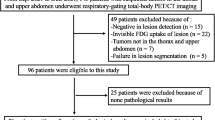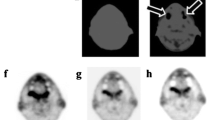Abstract
Purpose
State-of-the-art positron emission tomography/computed tomography (PET/CT) systems incorporate multislice CT technology, thus facilitating the acquisition of multiphase, contrast-enhanced CT data as part of integrated PET/CT imaging protocols. We assess the influence of a highly concentrated iodinated contrast medium (CM) on quantification and image quality following CT-based attenuation correction (CT-AC) in PET/CT.
Methods
Twenty-eight patients with suspected malignant liver lesions were enrolled prospectively. PET/CT was performed 60 min after injection of 400 MBq of 18F-fluorodeoxyglucose (FDG) and following the biphasic administration of an intravenous CM (400 mg iodine/ml, Iomeron 400). PET images were reconstructed with CT-AC using any of four acquired CT image sets: non-enhanced, pre-contrast (n-PET), arterial phase (art-PET), portal venous phase (pv-PET) and late phase (late-PET). Normal tissue activity and liver lesions were assessed visually and quantitatively on each PET/CT image set.
Results
Visual assessment of PET following CT-AC revealed no noticeable difference in image appearance or quality when using any of the four CT data sets for CT-AC. A total of 44 PET-positive liver lesions was identified in 21 of 28 patients. There were no false-negative or false-positive lesions on PET. Mean standardized uptake values (SUV) in 36 evaluable lesions were: 5.5 (n-PET), 5.8 (art-PET), 5.8 (pv-PET) and 5.8 (late-PET), with the highest mean increase in mean SUV of 6%. Mean SUV changes in liver background increased by up to 10% from n-PET to pv-PET.
Conclusion
Multiphase CT data acquired with the use of highly concentrated CM can be used for qualitative assessment of liver lesions in torso FDG PET/CT. The influence on quantification of FDG uptake is small and negligible for most clinical applications.







Similar content being viewed by others
References
Czernin J, Allen-Auerbach M, Schelbert HR. Improvements in cancer staging with PET/CT: literature-based evidence as of September 2006. J Nucl Med 2007;48 Suppl 1:78S–88S.
Antoch G, Freudenberg LS, Beyer T, Bockisch A, Debatin JF. To enhance or not to enhance? 18F-FDG and CT contrast agents in dual-modality 18F-FDG PET/CT. J Nucl Med 2004;45 Suppl 1:56S–65S.
Wong T, Paulson EK, Nelson RC, Patz Jr EF, Coleman RE. Practical approach to diagnostic CT combined with PET. AJR Am J Roentgenol 2007;188:622–9.
Kuehl H, Antoch G. How much CT do we need for PET/CT? A radiologist’s perspective. Nuklearmedizin 2005;44 Suppl 1:S24–31.
Pfannenberg A, Aschoff P, Brechtel K, Müller M, Klein M, Bares R, et al. Value of contrast-enhanced multiphase CT in combined PET/CT protocols for oncological imaging. Br J Radiol 2007;80:437–45.
Morimoto T, Tateishi U, Maeda T, Arai Y, Nakajima Y, Edmund Kim E. Nodal status of malignant lymphoma in pelvic and retroperitoneal lymphatic pathways: comparison of integrated PET/CT with or without contrast enhancement. Eur J Radiol 2008;67:508–13.
Strobel K, Bode B, Dummer R, Veit-Haibach P, Fischer DR, Imhof L, et al. Limited value of 18F-FDG PET/CT and S-100B tumour marker in the detection of liver metastases from uveal melanoma compared to liver metastases from cutaneous melanoma. Eur J Nucl Med Mol Imaging 2009;36:1774–82.
Soyka JD, Veit-Haibach P, Strobel K, Breitenstein S, Tschopp A, Mende KA, et al. Staging pathways in recurrent colorectal carcinoma: is contrast-enhanced 18F-FDG PET/CT the diagnostic tool of choice? J Nucl Med 2008;49:354–61.
Kinahan PE, Townsend DW, Beyer T, Sashin D. Attenuation correction for a combined 3D PET/CT scanner. Med Phys 1998;25:2046–53.
Hany TF, Steinert HC, Goerres GW, Buck A, von Schulthess GK. PET diagnostic accuracy: improvement with in-line PET-CT system: initial results. Radiology 2002;225:575–81.
Antoch G, Freudenberg LS, Egelhof T, Stattaus J, Jentzen W, Debatin JF, et al. Focal tracer uptake: a potential artifact in contrast-enhanced dual-modality PET/CT scans. J Nucl Med 2002;43:1339–42.
Beyer T, Antoch G, Bockisch A, Stattaus J. Optimized intravenous contrast administration for diagnostic whole-body 18F-FDG PET/CT. J Nucl Med 2005;46:429–35.
Mawlawi O, Erasmus JJ, Munden RF, Pan T, Knight AE, Macapinlac HA, et al. Quantifying the effect of IV contrast media on integrated PET/CT: clinical evaluation. AJR Am J Roentgenol 2006;186:308–9.
von Schulthess GK. Cost considerations regarding an integrated CT-PET system. Eur Radiol 2000;10:S377–80.
Kinahan P, Hasegawa B, Beyer T. X-ray based attenuation correction for positron emission tomography/computed tomography scanners. Semin Nucl Med 2003;33:166–79.
Nakamoto Y, Osman M, Cohade C, Marshall LT, Links JM, Kohlmyer S, et al. PET/CT: comparison of quantitative tracer uptake between germanium and CT transmission attenuation-corrected images. J Nucl Med 2002;43:1137–43.
Yau YY, Chan WS, Tam YM, Vernon P, Wong S, Coel M, et al. Application of intravenous contrast in PET/CT: does it really introduce significant attenuation correction error? J Nucl Med 2005;46:283–91.
Heusner T, Kuehl H, Veit-Haibach P, Hahn S, Boy C, Forsting M, et al. Highly iodinated intravenous contrast material for PET/CT - a feasibility study. Rofo 2008;180:740–5.
Berthelsen AK, Holm S, Loft A, Klausen TL, Andersen F, Højgaard L. PET/CT with intravenous contrast can be used for PET attenuation correction in cancer patients. Eur J Nucl Med Mol Imaging 2005;32:1167–75.
Townsend D. Multimodality imaging of structure and function. Phys Med Biol 2008;53:R1–39.
Awai K, Takada K, Onishi H, Hori S. Aortic and hepatic enhancement and tumor-to-liver contrast: analysis of the effect of different concentrations of contrast material at multi-detector row helical CT. Radiology 2002;224:757–63.
Marchianò A, Spreafico C, Lanocita R, Frigerio L, Di Tolla G, Patelli G, et al. Does iodine concentration affect the diagnostic efficacy of biphasic spiral CT in patients with hepatocellular carcinoma? Abdom Imaging 2005;30:274–80.
Brechtel K, Klein M, Vogel M, Mueller M, Aschoff P, Beyer T, et al. Optimized contrast-enhanced CT protocols for diagnostic whole-body 18F-FDG PET/CT: technical aspects of single-phase versus multiphase CT imaging. J Nucl Med 2006;47:470–6.
Miles KA. PET-CT in oncology: making the most of CT. Cancer Imaging 2008;4(8 Spec No A):S87–93.
Boellaard R. Standards for PET image acquisition and quantitative data analysis. J Nucl Med 2009;50:11S–20S.
Acknowledgement
This study was supported by Bracco Imaging Deutschland GmbH, Konstanz, Germany. We thank our technologists Henriette Heners and Agnetha Bürklin for their support on the data acquisition and study management.
Conflicts of interest
GE is an employee of Bracco Imaging Deutschland GmbH, Constance, Germany. TB is an employee of cmi-experts and reports no conflict of interest with this study.
Author information
Authors and Affiliations
Corresponding author
Rights and permissions
About this article
Cite this article
Aschoff, P., Plathow, C., Beyer, T. et al. Multiphase contrast-enhanced CT with highly concentrated contrast agent can be used for PET attenuation correction in integrated PET/CT imaging. Eur J Nucl Med Mol Imaging 39, 316–325 (2012). https://doi.org/10.1007/s00259-011-1919-5
Received:
Accepted:
Published:
Issue Date:
DOI: https://doi.org/10.1007/s00259-011-1919-5




